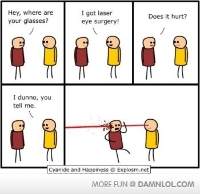You are using an out of date browser. It may not display this or other websites correctly.
You should upgrade or use an alternative browser.
You should upgrade or use an alternative browser.
Tell me a joke Thread
- Thread starter KMyers
- Start date
- Three Latvian are brag about sons. “My son is soldier. He have rape as many women as want,” say first Latvian. “Zo?” second say, “My son is farmer. He have all potato he want!” Third Latvian wait long time, then say, “My son is die at birth. For him, struggle is over.” “Wow! You are win us,” say others. But all are feel sad.
I am not sure that i get this one.
- Three Latvian are brag about sons. “My son is soldier. He have rape as many women as want,” say first Latvian. “Zo?” second say, “My son is farmer. He have all potato he want!” Third Latvian wait long time, then say, “My son is die at birth. For him, struggle is over.” “Wow! You are win us,” say others. But all are feel sad.
theres a lot of them:
https://www.reddit.com/r/Jokes/comments/14q1lq/collection_of_my_favorite_latvian_jokes/
It settles from a joke that Latvia is poor and cold, also dark,
https://www.reddit.com/r/Jokes/comments/14q1lq/collection_of_my_favorite_latvian_jokes/
It settles from a joke that Latvia is poor and cold, also dark,
(Just keep it PG)
Then PG13
Last edited by a moderator:
I do that intentionally every chance I get. I even go out of my way to go to the Apple store when I eat MexicanI farted in the Apple store and everybody got pissed. It's not my fault they don't have Windows...
In the orphan psychoblast, the half-formed navigator wired to the controls of the input channels began issuing a stream of requests for information. The first few thousand requests yielded nothing but a monotonous stream of error codes; they were incorrectly formed, or referred to non-existent sources of data. But every psychoblast was innately biased towards finding the polis library (if not, it would have taken millennia) and the navigator kept trying until it hit on a valid address, and data flooded through the channels: a gestalt image of a lion, accompanied by the linear word for the animal.
The navigator instantly abandoned trial and error and went into a spasm of repetition, summoning the same frozen image of the lion again and again. This continued until even the crudest of its embryonic change-discriminators finally stopped firing, and it drifted back towards experimentation.
Gradually, a half-sensible compromise evolved between the orphan’s two kinds of proto-curiosity: the drive to seek out novelty, and the drive to seek out recurring patterns. It browsed the library, learning how to bring in streams of connected information — sequential images of recorded motion, and then more abstract chains of cross-references — understanding nothing, but wired to reinforce its own behaviour when it struck the right balance between coherence and change.
Images and sounds, symbols and equations, flooded through the orphan’s classifying networks, leaving behind, not the fine details — not the spacesuited figure standing on grey-and-white rock against a pitch black sky; not the calm, naked figure disintegrating beneath a grey swarm of nanomachines — but an imprint of the simplest regularities, the most common associations. The networks discovered the circle/sphere: in images of the sun and planets, in iris and pupil, in fallen fruit, in a thousand different artworks, artifacts, and mathematical diagrams. They discovered the linear word for “person”, and bound it tentatively both to the regularities which defined the gestalt icon for “citizen”, and to the features they found in common among the many images of fleshers and gleisner robots.
By the five-hundredth iteration, the categories extracted from the library’s data had given rise to a horde of tiny sub-systems in the input-classifying networks: ten thousand word-traps and image-traps, all poised and waiting to be sprung; ten thousand pattern-recognising monomaniacs staring into the information stream, constantly alert for their own special targets.
[...]
Not long after the five-thousandth iteration, the orphan’s output navigator began to fire — and a tug-of-war began. The output navigator was wired to seek feedback, to address itself to someone or something that showed a response. But the input navigator had long since grown accustomed to confining itself to the polis library, a habit which had been powerfully rewarded. Both navigators were wired with a drive to bring each other into alignment, to connect to the same address, enabling the citizen to listen and speak in the same place — a useful conversational skill. But it meant that the orphan’s chatter of speech and icons flowed straight back to the library, which completely ignored it.
Faced with this absolute indifference, the output navigator sent repressor signals into the change-discriminator networks, undermining the attraction of the library’s mesmerising show, bullying the input navigator out of its rut. [...]
When the orphan stumbled on the address for a Konishi forum, it saw a square paved with smooth rhombuses of mineral blues and greys, arranged in a pattern dense with elusive regularities but never quite repeating itself. A fountain sprayed liquid silver towards a cloud-streaked, burnt-orange sky; as each stream broke apart into mirrored droplets half-way up its arc, the shiny globules deformed into tiny winged piglets which flew around the fountain, braiding each others’ flight paths and grunting cheerfully before diving back into the pool. Stone cloisters ringed the square, the inner side of the walkway a series of broad arches and elaborately decorated colonnades. Some of the arches had been given unusual twists — Eschered or Kleined, skewed through invisible extra dimensions.
The orphan had seen similar structures in the library, and knew the linear words for most of them; the scape itself was so unremarkable that the orphan said nothing about it at all. And the orphan had viewed thousands of scenes of moving, talking citizens, but it was acutely aware of a difference here, though it could not yet grasp clearly what it was. The gestalt images themselves mostly reminded it of icons it had seen before, or the stylised fleshers it had seen in representational art: far more diverse, and far more mercurial, than real fleshers could ever be. Their form was constrained not by physiology or physics, but only by the conventions of gestalt — the need to proclaim, beneath all inflections and subtleties, one primary meaning: I am a citizen.
The orphan addressed the forum: “People.”
The linear conversations between the citizens were public, but muted — degraded in proportion to distance in the scape — and the orphan heard only an unchanging murmur.
It tried again. “People!”
The icon of the nearest citizen — a dazzling multihued form like a stained-glass statue, about two delta high — turned to face the orphan. An innate structure in the input navigator rotated the orphan’s angle of view straight towards the icon. The output navigator, driven to follow it, made the orphan’s own icon — now a crude, unconscious parody of the citizen’s — turn the same way.
[...]
The feedback detector backtracked on its satisfaction rating, making the navigators restless again. Not restless enough to abandon the forum, but enough to move within it.
The orphan darted from place to place, crying out: “People! Hello!” It moved without momentum or inertia, gravity or friction, merely tweaking the least significant bits of the input navigator’s requests for data, which the scape interpreted as the position and angle of the orphan’s point-of-view.
[...]
Gradually, the orphan’s input-classifying networks began to grasp the difference between the citizens in the forum and all the icons it had seen in the library. As well as the image, each icon here exuded a non-visual gestalt tag — a quality like a distinctive odour for a flesher, though more localised, and much richer in possibilities. The orphan could make no sense of this new form of data, but now its infotrope — a late-developing structure which had grown as a second level over the simpler novelty and pattern detectors — began to respond to the deficit in understanding. It picked up the tenuous hint of a regularity — every citizen’s icon, here, comes with a unique and unvarying tag — and expressed its dissatisfaction. The orphan hadn’t previously bothered echoing the tag, but now, spurred on by the infotrope, it approached a group of three citizens and began to mimic one of them, tag and all. The reward was immediate.
The citizen exclaimed angrily, “Don’t do that, idiot!”
“Hello!”
“No one will believe you if you claim to be me — least of all me. Understand? Now go away!” This citizen had metallic, pewter-grey skin. Ve flashed vis tag on and off for emphasis; the orphan did the same.
“No!” The citizen was now sending out a second tag, alongside the original. “See? I challenge you — and you can’t respond. So why bother lying?”
“Hello!”
“Go away!”
The orphan was riveted; this was the most attention it had ever received.
“Hello, citizen!”
The pewter face sagged, almost melting with exaggerated weariness. “Don’t you know who you are? Don’t you know your own signature?”
Another citizen said calmly, “It must be the new orphan — still in the womb. Your newest co-politan, Inoshiro. You ought to welcome it.”
This citizen was covered in short, golden-brown fur. The orphan said, “Lion.” It tried mimicking the new citizen — and suddenly all three of them were laughing.
The third citizen said, “It wants to be you now, Gabriel.”
The first, pewter-skinned citizen said, “If it doesn’t know its own name, we should call it ‘idiot.’”
“Don’t be cruel. I could show you memories, little part-sibling.” The third citizen’s icon was a featureless black silhouette.
[...]
The input navigator spun the orphan’s angle of view, trying to see what the citizen was pointing at. When it found nothing behind the orphan, it moved its point of view backwards, closer to the golden-furred citizen — momentarily breaking step with the output navigator.
Suddenly, the orphan saw the icon it was projecting itself — a crude amalgam of the three citizens’ icons, all black fur and yellow metal — not just as the usual faint mental image from the cross-connected channels, but as a vivid scape-object beside the other three.
[...]
The orphan watched the fourth citizen change shape and colour, out there in the scape … changes perfectly mirroring its own random fidgeting: sometimes mimicking one of the other three citizens, sometimes simply playing with the possibilities of gestalt. This mesmerised the regularity detectors for a while, but it only made the infotrope more restless.
[...]
The input navigator drifted of its own accord back into the same location as the output navigator, and the fourth citizen abruptly vanished. The infotrope pushed the navigators apart again; the fourth citizen reappeared.
[...]
The orphan moved between the library and the scape with the orange sky and the flying-pig fountain.
[...]
“I followed ver and ve jumped and jumped … and I followed ver!” The orphan made a few short jumps around the three of them, trying to illustrate the point, though it didn’t really convey the business of leaping right out of one scape into another.
Inoshiro said, “Ssh. Here it comes.”
The orphan followed vis gaze to an irregular lump of rock in the distance — lit by the sun, one half in deep shadow — moving swiftly and steadily towards the loose assembly of citizens. The scape software decorated the asteroid’s image with gestalt tags packed with information about its chemical composition, its mass, its spin, its orbital parameters; the orphan recognised some of these flavours from the library, but it had no real grasp yet of what they meant.
“One slip of the laser, and the fleshers die in pain!” Inoshiro’s pewter eyes gleamed.
Blanca said dryly, “And just three hundred millennia to try again.”
Inoshiro turned to the orphan and added reassuringly, “But we’d be all right. Even if it wiped out Konishi on Earth, we’re backed-up all over the solar system.”
[...]
For the five-thousand-and-twenty-third time, the conceptory checked the architecture of the orphan’s mind against the polis’s definition of self-awareness.
Every criterion was now satisfied.
The conceptory reached into the part of itself which ran the womb, and halted it, halting the orphan. It modified the machinery of the womb slightly, allowing it to run independently, allowing it to be reprogrammed from within. Then it constructed a signature for the new citizen — two unique megadigit numbers, one private, one public — and embedded them in the orphan’s cypherclerk, a small structure which had lain dormant, waiting for these keys. It sent a copy of the public signature out into the polis, to be catalogued, to be counted.
Finally, the conceptory passed the virtual machine which had once been the womb into the hands of the polis operating system, surrendering all power over its contents. Cutting it loose, like a cradle set adrift in a stream. It was now the new citizen’s exoself: its shell, its non-sentient carapace. The citizen was free to reprogram it at will, but the polis would permit no other software to touch it. The cradle was unsinkable, except from within.
Inoshiro said, “Stop it! Who are you pretending to be now?”
Yatima didn’t need to part the navigators; ve knew vis icon hadn’t changed appearance, but was now sending out a gestalt tag. It was the kind ve’d noticed the citizens broadcasting the first time ve’d visited the flying-pig scape.
Blanca sent Yatima a different kind of tag; it contained a random number encoded via the public half of Yatima’s signature. Before Yatima could even wonder about the meaning of the tag, vis cypherclerk responded to the challenge automatically: decoding Blanca’s message, re-encrypting it via Blanca’s own public signature, and echoing it back as a third kind of tag. Claim of identity. Challenge. Response.
Blanca said, “Welcome to Konishi, Citizen Yatima.” Ve turned to Inoshiro, who repeated Blanca’s challenge then muttered sullenly, “Welcome, Yatima.”
Gabriel said, “And Welcome to the Coalition of Polises.”
qrwteyrutiyoup
Member
mikho
Not to be taken seriously, ever!
I once stayed at a hotel near a cemetery, I call that a near death experience.So this helicopter crashes into a cemetery... the cops report finding 378 casualties.




